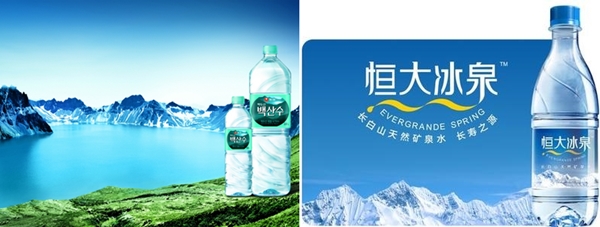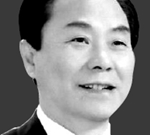Baekdu versus Changbai
Published: 28 Aug. 2014, 20:42

“Hengda Water,” right, spring water being developed by Hengda Group of China, and Baeksansu, a mineral water developed by Nongshim Group of South Korea, are both sourced from the volcanic Cheonji lake on top of Mt. Baekdu (Mt. Changbai in China). Provided by the company

Kim Hwan-gi
A Thai company, Chia Tai, has also joined in to develop spring water from Mount Baekdu, and South Korea and North Korea may also go after it at any time.
Excessive exploitation of spring or hot water would not only lower the water level on Mt. Baekdu, but cause underground voids that could trigger a volcanic eruption. As Mt. Baekdu was recently named one of 10 major ecological tourist attractions of China, many people are visiting. North Korea is also bringing foreign trout to Cheonji, an oligotrophic lake on top of Mt. Baekdu, which may cause serious damage to the local ecosystem.
Now, how is Mt. Changbai different from Mt. Baekdu? It is necessary to address this issue. Everyone in Korea knows Mt. Baekdu. But we must clarify China’s position. Korea and China had thousands of years of bloody disputes over territorial issues. In 1962, Kim Il Sung and Zhou Enlai met in Pyongyang to secretly sign the Korea-China Border Agreement, allowing China to administer the northern part of Cheonji while the southern part of the lake was left to North Korea. As a result, Mt. Baekdu has been divided in half and Cheonji is called Changbaishan Tianchi in Chinese. It is frustrating to hear North Korea brag that it occupies 54.5 percent of the lake.
North Korea always emphasizes “the Baekdu Clan” - the mountain is Kim Jong-il’s mythical birthplace and Kim Il Sung allegedly rallied his revolutionary forces here - so it had to safeguard Mt. Baekdu in the border agreement. China argues that the people of Manchuria have always called the region Mt. Changbai and hence refers to all of Mt. Baekdu as Mt. Changbai. But geographically, Mt. Changbai is only a part of Mt. Baekdu. When the two Koreas reunify, the Korea-China border agreement should be rewritten to retrieve Mt. Baekdu. The key could be the Korea-China Border Protocol that was signed in Beijing in 1964 without our consent, since this is only a protocol, not a treaty.
Nurhachi, founder of the Qing Dynasty, declared Mt. Changbai as the “green region” and banned settlements as it was considered to be the mythical birthplace of his ancestors. But the hidden motive was to keep foreign settlements out. This also is the site of sad history. When Japan founded a puppet state in Manchuria with Pui, the last emperor of the Qing Dynasty, it forced Korean people to relocate to the region to supply the Japanese army.
An important epitaph is engraved on the three-nation border monument in Fangchuan, China, which was erected by Wudacheng, a government official from the late Qing Dynasty, after signing a border treaty with Russia. Joseon and Qing fought over the meaning of these engravings (Tomun) on the Mt. Baekdu Monument erected during the Joseon reign of King Sukjong (1661-1720). Who would have ever imagined that the two letters of “Tomun” would give China a chance to argue about the border? Fortunately, the fact that the Qing Dynasty acknowledged the monument is clear evidence of China’s former recognition that Mt. Baekdu is not Mt. Changbai.
A national geographic map, however, still marks Mt. Baekdu as Mt. Changbai, Amnokgang as Yalu River after the Chinese pronunciation and Duman River as Tumen River. Also, the name Yellow Sea may sound fair and neutral, but it originates from the Yellow River in China.
The Greater Tumen Initiative declared by Chinese President Xi Jinping and Korean President Park Geun-hye includes a long-term development plan for the four countries surrounding the Tumen River, including the East Coast of Korea, the three northeastern provinces of China, Primorsky Krai of Russia and Inner Mongolia.
The English name, Greater Tumen Initiative, is contested among Koreans such as myself. We demand that it should be called Greater Duman Initiative, after the Korean name of Dumangang. What have we learned from Dokdo and Takeshima, the East Sea and Sea of Japan, West Sea and Yellow Sea? We should not forget that there is, after all, a war without guns going on between the Diaoyu Archipelago and the Senkaku Shoto.
* The author is a professor emeritus at Chonbuk National University and a former president of Korean Society of Environmental Engineers.
BY Kim Hwan-gi










with the Korea JoongAng Daily
To write comments, please log in to one of the accounts.
Standards Board Policy (0/250자)